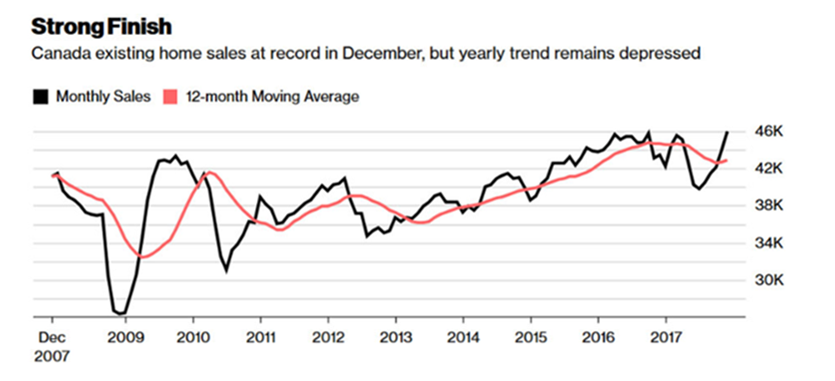
Canadian home sales rose to a record in December just before tougher mortgage rules took effect, helping make 2017 the second strongest market ever. Transactions climbed 4.5 percent from November to 45,976, according to a report in early January by the Canadian Real Estate Association. The national benchmark price index was little changed on the month and was up 9.1 percent from 12 months earlier. Clearly it is apparent that home buyers were racing to get ahead of more stringent mortgage eligibility rules that took effect on Jan. 1, 2018 potentially distorting year-end sales figures.
2017 was the second strongest year for sales on record, and included strong gains in prices. It will be interesting to see if monthly sales activity continues to rise despite tighter mortgage regulations that took effect on January 1st.
Sales in December rose in about 60 percent of markets led by Toronto, Calgary and the Vancouver area. The December surge brings the streak of gains to five months. Sales for all of 2017 fell by 4 percent from 2016’s record. The Canadian Real Estate Association forecasts that sales will have another down year in 2018 as demand gets weighed down by rising mortgage rates and a new federal rule requiring borrowers show they can afford payments that are much higher than current market rates.
As a collection agency in Edmonton, Calgary and the GTA we are watching with keen interest the unfolding of events with respect to these phenomenon and their impact (or lack thereof) on Canadian credit markets.
While national home prices have come down since peaking in May 2017 it still proved to be a strong year. The 9.1 percent year-over-year price gain in December is the second largest appreciation for that month in the past decade.

Deteriorating Housing Affordability
Meanwhile, RBC Economics in a report published in December 2017 says housing affordability in Canada is at its worst level since 1990. No surprise there, nor is there any surprise to see Vancouver, Toronto and Victoria as the least affordable markets (where it will take 87.9 per cent, 78.4 per cent and 61.5 per cent, respectively, of household income to cover the cost of mortgages). Looking for relief? Saint John is Canada’s most affordable market (where 24.5 per cent of household income goes toward mortgage servicing costs).
Read more here: http://www.rbc.com/newsroom/_assets-custom/pdf/20171221-ha.pdf